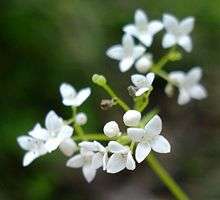Rubieae
Rubieae is a tribe of flowering plants in the family Rubiaceae and contains 969 species in 14 genera. The genus Galium is responsible for more than two thirds of the species in the tribe. The second largest genus is Asperula, which contains about 200 species. Unlike the rest of the family Rubiaceae, the tribe contains predominantly perennial and annual herbs with pseudowhorls of leaves and leaflike stipules and is centered in temperate and tropical-mountain regions.[1]
| Rubieae | |
|---|---|
 | |
| Galium uliginosum | |
| Scientific classification | |
| Kingdom: | Plantae |
| Clade: | Tracheophytes |
| Clade: | Angiosperms |
| Clade: | Eudicots |
| Clade: | Asterids |
| Order: | Gentianales |
| Family: | Rubiaceae |
| Subfamily: | Rubioideae |
| Tribe: | Rubieae Baill. |
Genera
Currently accepted names
- Asperula L. (191 sp)
- Callipeltis Steven (3 sp)
- Crucianella L. (31 sp)
- Cruciata Mill. (8 sp)
- Didymaea Hook.f. (8 sp)
- Galiasperula Ronniger (1 sp)
- Galium L. (631 sp)
- Kelloggia Torr. ex Benth. & Hook.f. (2 sp)
- Mericarpaea Boiss. (1 sp)
- Microphysa Schrenk (1 sp)
- Phuopsis Steven (1 sp)
- Rubia L. (83 sp)
- Sherardia L. (1 sp)
- Valantia L. (7 sp)
Synonyms
- Asperugalium P.Fourn. = Galiasperula
- Relbunium (Endl.) Hook.f. = Galium
- Warburgina Eig = Callipeltis
gollark: CSS is great in that it can do some tasks *really well*, but horrible in that when you step slightly outside of the range the people who wrote the standards considered everything breaks.
gollark: It was a response. Possibly not a contextually appropriate one, but too bad.
gollark: Well, you can't actually do those things with open source drivers probably.
gollark: National security reasons.
gollark: Why are you quoting some subset of your own sentences?
References
- Natali A, Manen JF, Ehrendorfer F (1995). "Phylogeny of the Rubiaceae-Rubioideae, in particular the tribe Rubieae: evidence from a non-coding chloroplast DNA sequence". Annals of the Missouri Botanical Garden. 82 (3): 428–439. doi:10.2307/2399892. JSTOR 2399892.
External links
| Wikispecies has information related to Rubieae |
| Wikimedia Commons has media related to Rubieae. |
This article is issued from Wikipedia. The text is licensed under Creative Commons - Attribution - Sharealike. Additional terms may apply for the media files.